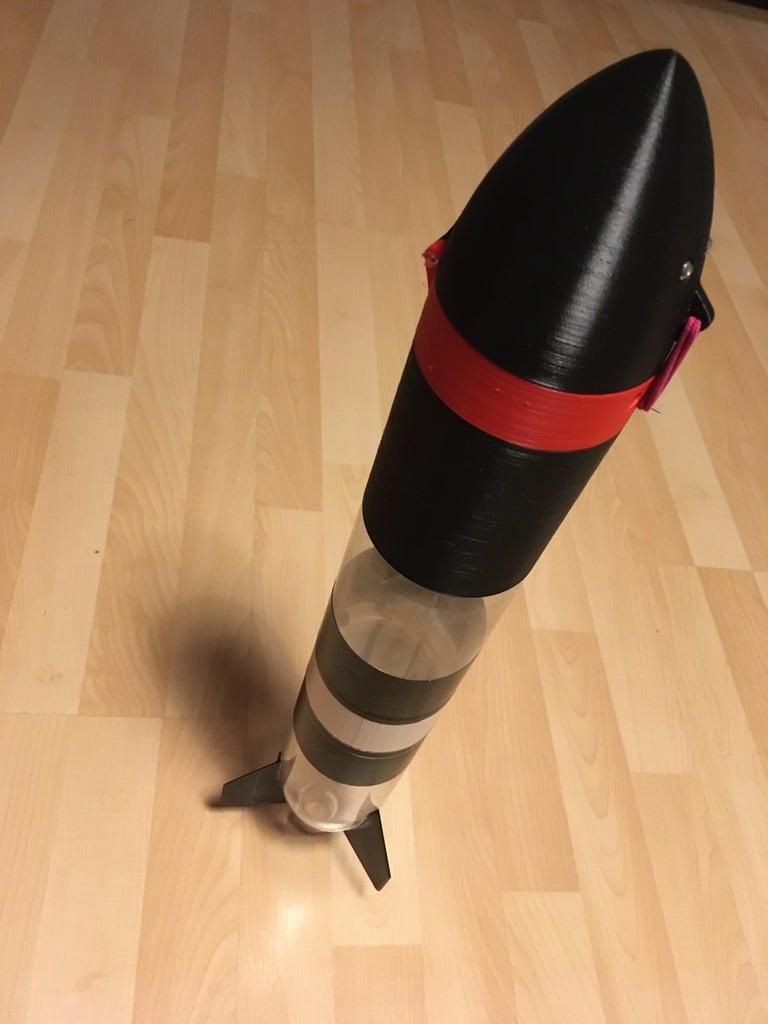
Rocket Parachute Capsule – Arduino Controlled
thingiverse
This is a low-cost Arduino-based barometric altimeter parachute releaser on the apogee for water-powered PET-Rockets. Measured data will be saved to an SD-Card, if desired. Among other things, it saves data on velocity and height. The device will be mounted on top of a PET-bottle. It is essential that the body of the rocket has two bottle openings: one for the rocket booster and one for mounting the altimeter chute capsule. Update 03_2020: Some issue corrections in 3D models for slicing with Cura. Added a body for a 9V battery. Update 04_2020: Added a flap for PET (Apollinaris or Schweppes brand). For those who wonder which bottles this was built for; I forgot to mention it earlier. Here are some good explanations: http://www.raketfuedrockets.com First Flight 05_2020: Wow! It worked well on every flight. I will upload some pictures soon (added now). I already published flight data in graphs, see pics. At first, wire and solder the modules, see wiring diagram. If you want to use a 9V block, you need to regulate the voltage for the servo otherwise these little servos will be killed by using 6.8V above. I am using a 6.6V 320mAh LiFe battery, so that the system will be long-lasting and the weight will be almost okay. Connecting the servo to the 5V output on the NANO might not be a good idea because the servo may draw too much current and will most likely fry the board - maybe it's possible with these little ones but I haven't tried it yet. I would appreciate some feedback if it works directly on the 5V pin on the Nano. Update: Some guys attached 9g servos on 5Vcc board-pin and obviously, it worked... see here: https://www.instructables.com/id/How-to-usa-a-Servo-motor-Arduino-Tutorial/ Download all 3D parts and the Arduino sketch txt-file and rename the file ending into .ino then it is usable for Arduino IDE or copy the text and paste in a new Arduino file. This is an improved sketch (based on the concept by M. Goltzsch) extended with an OLED display and a Kalman filter to smooth the measured data. You can find the exotic Arduino libs (SimpleKalmanFilter.h and SSD1306Ascii.h) as links to GitHub in the comments (find it in the sketch) or below this text. Please note that the standard Adafruit display lib will consume too much resources - uploading the sketch to the nano won't be possible in this case. Download and install these libs in Arduino IDE before uploading the sketch to the Nano. The other standard libs like wire.h, spi.h, sd.h, or servo.h should be clear and can be found easily in the IDE. The mounting is quite simple. You need some M3 screws and nuts, a PET-strip cutted from a bottle for the release spring, 1mm steel pin for the servo, 1.5 mm steel pin for the hinge, a cap for PET-bottles, (hair) rubber, and last but not least a tiny hook to attach the chute. List of parts: -Arduino Nano -SD-Card reader (use the IC 5V regulated; the others may cause issues) -BMP180 (or others with the correct lib) -OLED Display I2C 128x32px -Akku or 9V block (-5V regulator if you use more than 6.6V) -Micro Slide Switch (15mm hole distance with 2mm holes) -Servo 3.7g -some screws and nuts M3 -rubber (hair ring) -0.8-1 mm steel pin for release system -1.5 mm steel pin for the hinge -PET-strip for release spring -cap of a PET-bottle -a tiny hook to screw in Links to the exotic Arduino Libs: https://github.com/greiman/SSD1306Ascii https://github.com/denyssene/SimpleKalmanFilter For those who have plenty of time to build a very nice chute, then use this helpful App "Chute Maker" by Th. Schmid; search for the download link in this thread: https://www.raketenmodellbau.org/forum?action=viewthread&threadid=801226&page=1 Have fun and try it yourself. Feel free to improve and share it. Non-commercial-use-only I am not responsible for external links
With this file you will be able to print Rocket Parachute Capsule – Arduino Controlled with your 3D printer. Click on the button and save the file on your computer to work, edit or customize your design. You can also find more 3D designs for printers on Rocket Parachute Capsule – Arduino Controlled.
